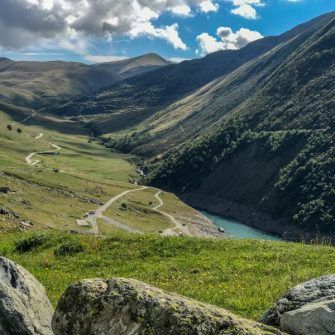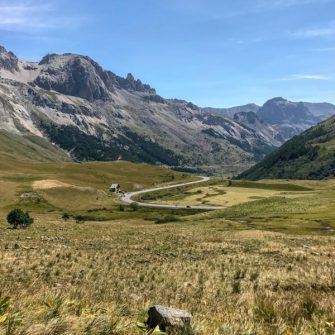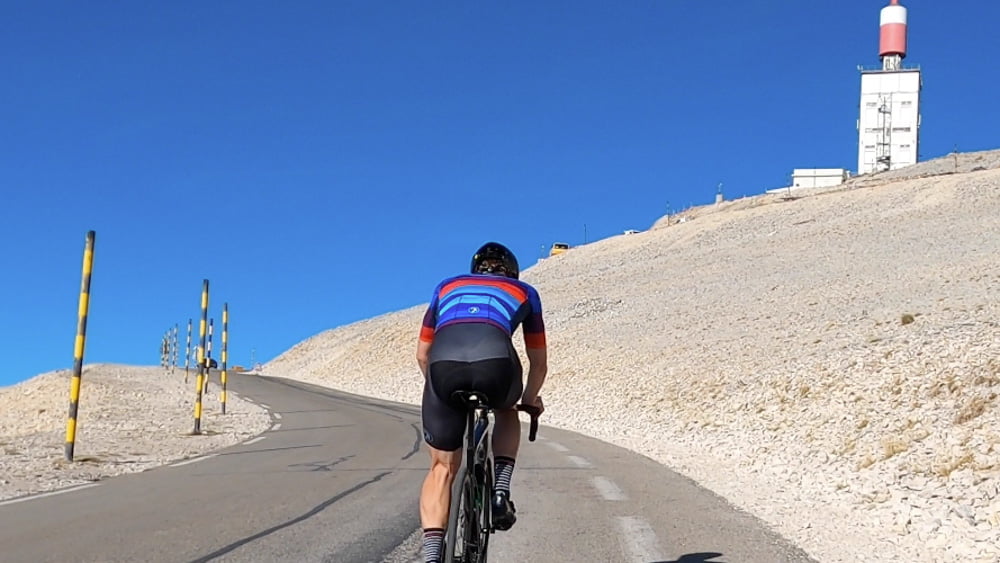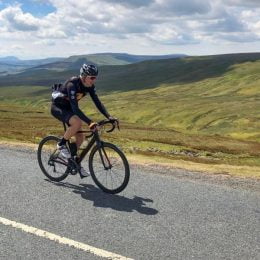If you’re a keen cyclist, then cycling in the Alps in summer is one of those things you just have to experience. Whether it’s because of the Tour de France or simply as a result of the iconic images of snow-capped peaks, shimmering glaciers and lush green meadows embedded in your mind, Alpine cycling is a must for many a cyclist.
The Alps are the highest mountain chain in Europe and cover a huge area, including France, Switzerland, northern Italy and Austria before heading south towards the Balkan states. To give you some idea of the distances involved, as the crow flies, it is approximately 400 kilometres from the Cote d’Azur in the south of France to Lac Leman, on the border with Switzerland, but over 600 kilometres by car!
Given the Alps are so huge, we thought it would be helpful to break them down a bit in order to help you plan a future road cycling holiday in the Alps.
This article will focus upon France. It will focus on the best bases for cycling in the French Alps and the best cycling climbs in France, with the aim of helping you narrow down the regions/climbs you want to tackle on your next cycling holiday in the French Alps.
What are the Alps?
While many of us think of the Alps as being a mountainous area of southeast France, Switzerland and Italy, in fact the word “Alp” strictly refers to an upland mountain pasture which lies just below the snow-line. They are meadows, where hay is cut in the lower fields and where, in the summer months, the Alpine farmers take their cattle to graze. There’s more on the history of the Alps here.
The Alps are made up of mountain ranges that are separated by deep valleys, most of which lie west to east and south-west to north-east.
It’s these meadows and mountain ranges that make up the cyclist’s playground that is the Alps.
 Lac de Grand Maison near Croix de Fer, French Alps
Lac de Grand Maison near Croix de Fer, French Alps Meadows on the Col de l’Iseran
Meadows on the Col de l’Iseran
Where are the Alps?
The Alps stretch way beyond France. They extend north, in a crescent shape, from the Cote d’Azur up through Switzerland, northern Italy, Austria and the Balkan states.
The countries with the largest Alpine landmass are Austria 29%, Italy 27%, France 21% and Switzerland 13%.
Why go cycling in the Alps?
Summer in the French Alps is extremely popular. The Alps attract over 100 million tourists per year, descending from all over the world! The good news is that the Alps are so vast that it won’t feel like there are that many people here (unless you happen to visit as the Tour de France rolls by… (for info on how to do that, read this article)).
People visit for the craggy vertiginous summits, with some peaks stretching as much as 4,000 metres into the sky, huge glaciers and clear mountain lakes. The warmer valleys have seemingly endless meadows, huge forests and are home to thousands of different forms of wildlife.
There is a permanent snow blanket at around 3,000 metres above sea level and plenty of opportunity for cyclists to scale the numerous 2,000 metre plus peaks.
Many cyclists view cycling the Alps as the ultimate test to challenge themselves on the famous Tour de France climbs. Mountains such as Alpe d’Huez, Col de l’Iseran and Col de Galibier, amongst many others, have now become legendary and iconic ascents within the cycling world.
 Col de Lauteret, near the Col de Galibier
Col de Lauteret, near the Col de Galibier Mountain pastoral bliss on the Col de la Madeleine
Mountain pastoral bliss on the Col de la Madeleine
Regions of the French Alps (for cyclists)?
To make planning your Alps cycling trip easier, we have split the French Alps into three broad geographical areas:
North
From Bourg Saint Maurice towards both Lake Annecy and Lac Leman (Lake Geneva) which encompasses some Tour de France classics such as Col de Joux Plan, Col de Colombiere and Mont du Chat.
Central
From Bourg d’Oisans northwards to the Bourg Saint Maurice area including, amongst others, the legendary Alpe d’Huez, Col de Madeleine and the Cormet de Roselend.
South
From the Cote d’Azur northwards towards Bourg d’Oisans and Briançon. This will include for example the many cycling climbs around Nice and the area around Mont Ventoux.
We will spend the rest of this article going into more depth on each of these three regions, sharing our experience of what each area is like for cyclists, picking out some of the best French Alps towns and villages to stay in and the kind of cycling climbs you’ll have at your door.
We work broadly from the north of the Alps to the south, to help you with orientation; we appreciate it can be confusing to understand the geography of how each of these places and the cycling climbs fits together.
While we endeavour to ensure this article shares some of the best bases for cycling in the French Alps, the reality is that the French Alps cover a vast area and there are lots of places and climbs we won’t get a chance to mention. What we’re seeking to do here is provide a framework/overview to help you plan which part you want to visit.
We hope it helps!
Northern Alps
1. Why visit the northern Alps
The area between Albertville and Lac Leman is very popular with summer holiday makers due to the proximity of the well-known resorts of Lake Annecy and Bourget du Lac to the west and Lac Leman (Lake Geneva) to the north.
 Cycling above Lake Annecy
Cycling above Lake Annecy View across Lake Geneva (credit: Cyclomundo)
View across Lake Geneva (credit: Cyclomundo)
2. Cycling climbs of the Northern Alps
Thonon-les-Bains and Evian-les-Bains
Sitting on the side of the glorious Lake Geneva (AKA Lac Leman), these grand old towns make great bases for exploring by bike. Evian-les-Bains was once fortified and is known as “the pearl of Lake Geneva”. It’s also the historical home of Evian bottled water. From these towns, you can tackle the Tour du Lac Leman and there’s plenty of climbing, though it’s not the really famous sort (Col du Grand Taillet, Col du Corbier and Pointe de Trechauffex for example).
Morzine
Another Tour de France favourite, the fearsome Col de Joux Plan, is situated near to Morzine and is usually climbed together with the nearby Col de la Ramaz. From Morzine, there are also climbs of the Col du Corbier and up to the ski resort at Avoriaz.
Chamonix
To the southeast of Morzine and Lake Geneva lies the Chamonix region. It’s near Switzerland and the imposing mountain of Mont Blanc, which lies near the France/Italy border. Mont Blanc is the highest peak in the Alps and rises to 4,808 metres. You can drive under the mountain, from France into Italy, through the famous Mont Blanc tunnel which is almost 12 kilometres in length.
Mont Blanc is to the south of Chamonix; north of Chamonix you find the Col des Montets followed by the major obstacle, Col de la Forclaz, just across the border in Switzerland.
Annecy and La Clusaz
To the southwest of Morzine and Lake Geneva is Lake Annecy. Nearby, the Col des Saisies and Col des Aravis are often climbed in succession in the Tour de France as are the Grand Bornand and nearby Col de la Colombière. All can be accessed from either Annecy or La Clusaz. There are also plenty of lesser-known climbs in the mountains surrounding Lake Annecy.
Aix-les-Bains and Lac de Bourget
West of Lake Annecy lies Lac de Bourget. On its shores sits Aix-les-Bains, which has been known as a spa since before the arrival of the Romans. From this idyllic lake, the extremely difficult Mont du Chat is right on the doorstep whilst a little further afield, to the north, the Col de Biche and Grand Colombier lie in wait.
3. Our pick of where to stay in the northern Alps
Like the central region of the Alps, the northern region is a very popular skiing destination. In addition to the areas around the lakes, the French Alps towns of Morzine and La Clusaz make ideal French Alps cycling holiday bases.
- Morzine (Col de Joux Plan, Col de la Ramaz)
- La Clusaz (Col des Saisies, Col des Aravis)
- Lake Annecy (Le Grand Bornand, Col de la Colombière)
- Lac de Bourget (Mont du Chat, Col de la Biche, Grand Colombier)
4. More information
- Our article on cycling around Geneva.
- Our article on cycling around Lac Leman (NB the lake is known as Lake Geneva on the Swiss side of the border)
Central Alps
1. Why visit the Central Alps?
Moving south towards Bourg d’Oisans, you start to get into consistently higher ground and what you might term as “typical Tour de France terrain”, including some of the best cycling climbs in France.
This central area is very mountainous with a lot of accessible peaks at around 2,500 metres in altitude. It has what you might describe as typical alpine feel and you need to plan your trip carefully to get the most out of it. Also remember to take a wind jacket with you for the descents!
It’s such a huge area that it’s best to pick a base and cover the climbs in that area before perhaps moving to another town to do some more and so on.
 Quiet roads near Alpe d’Huez
Quiet roads near Alpe d’Huez Switchbacks on Alpe d’Huez
Switchbacks on Alpe d’Huez
2. Cycling climbs of the Central Alps
Here you will find some of the most famous cycling climbs in the Alps, including the Tour de France’s most classic climbs, such as Alpe d’Huez with its famed 21 bends, Col du Galibier, and the Col de Madeleine. The region is perfect for a cycling tour of the Alps as there are so many popular mountains and routes.
If climbing the famous mountains is the main objective of your cycling holiday, then this is the best part of the Alps to choose.
Bourg Saint Maurice
Starting from the northern part of the central Alps, you have a town that’s a favourite with the Tour de France: Bourg Saint Maurice. The town lies east of Albertville and from here you’ve got a fabulous opportunity to pull in such notable ascents as Col de l’Iseran (north), Cormet de Roselend and Col du Pré. You also have the opportunity to explore the ascent to La Rosiere and the nearby Col du Petit Saint Bernard which tops out at the border crossing point. There are also ski station climbs up to Les Arcs and Tignes.
Another advantage of staying in Bourg Saint Maurice is that it is situated very near to the border with the Italy. The area in the valley of Aosta and Piemonte has some world class climbs made famous by the Giro d’Italia.
The Colle dell Agnello, Colle dello Finestre and the climb to the ski station at Sestriere are all a short drive and cycle away.
Moûtiers
30km southwest of Bourg Saint Maurice is Moûtiers. From here lies the Col de la Loze, the new Tour de France climb. Situated in the Trois Vallées area near the ski town of Moûtiers and topping out at 2,304 metres, the road to the Col de Loze was completed in 2019 after an old mountain path was asphalted.
The new road now links the ski towns of Courchevel with Méribel and on the Courchevel side the final 5.8 kilometres of the limb are for cyclists only.
You can find out about the Col de la Loze sportive here.
Bourg d’Oisans
90km southwest of Moûtiers, and just west of Grenoble, sits the famous cycling town of Bourg d’Oisans.
At Bourg d’Oisans you are at the foot of Alpe d’Huez and within easy reach of Col du Lauteret, Col de la Croix de Fer and the Col du Glandon. There’s also the memorably beautiful Col de la Sarenne, the Col d’Ornon and some incredible balcony roads that merit a few days of riding.
Saint Jean de Maurienne
One the other side of the valley from Bourg d’Oisans is the Maurienne Valley. This is a popular alternative to Bourg d’Oisans, and gives easy access to the very famous climbs of Col de Madeleine, Col du Telegraphe and Col du Galibier.
Vercors region
The Vercors Massif lies south west of Grenoble and straddles the two departments of Isère and Drôme. Sometimes referred to as the Grenoble Alps or the Pre-Alps the area is also closely situated to the city of Valence and the main A7 motorway which runs south towards the Cote d’Azur and Spain.
The Vercors landscape is gnarly and undulating and famous for its many balcony roads which have been cut out of huge limestone cliffs on the top of deep gorges. Like many regions in this part of the world the Vercors Natural Park is a very popular skiing destination and as such the terrain provides ample opportunities for cyclists.
One of the well-known climbs in the Vercors is the Category 1 ascent of the Côte de Saint-Nizier-du-Moucherotte (14.6k @ 6.8%). The Tour de France passed this way in 2020 finishing at the ski station in nearby Villard de Lans.
The area is packed with medium sized Cols and stunning gorges and is described by some as one of the most under rated areas within the entire Alpine chain. Definitely one to take a closer look at!
The Vercors is also an ideal stopover area if you are travelling south and want to break up your journey and stretch your legs for a day or so on the bike. There are ample accommodation and restaurant facilities in Grenoble as well as in the old medieval town of Romans sur Isère which is even closer to the motorway.
Marmotte Gran Fondo
An article on the central Alps would not be complete without a section on the internationally renowned Marmotte Gran Fondo. Each year 7,500 cyclists ride a 175-kilometre loop, with around 5,000 metres of elevation, starting in Bourg d’Oisans and finishing at the top of nearby Alpe d’Huez.
The route includes the ascents of the Col du Glandon, Col du Telegraphe and the 2,645-metre climb of the Col du Galibier before arriving at Alpe d’Huez. This event is probably the ultimate cycling challenge in the Alps.
This article gives in-depth information about the Marmotte Gran Fondo.
3. Our pick of where to stay in the central Alps
The towns and ski resorts of this region have plentiful accommodation in the summertime with all the facilities that you will need during your stay.
Choose Bourg d’Oisans, Saint Jean de Maurienne or Bourg Saint Maurice and not only will you will be well catered for in terms of accommodation and facilities, but you will have sufficient climbs to keep you well occupied for at least 4 or 5 days of riding some of the best French Alps cycling routes.
- Bourg d’Oisans (Alpe d’Huez, Col du Glandon etc)
- Saint Jean de Maurienne (Col du Telegraphe, Col du Galibier etc)
- Moûtiers (Col de la Loze)
- Bourg Saint Maurice (Col de l’Iseran, Cormet de Roselend etc and Italian Alps)
4. More information
Our guide to cycling the French Alps including Alpe d’Huez and surrounding area.
Our article on where to stay near Alpe d’Huez.
Our guide to Col de l’Iseran and surrounding area.
Our guide to cycling the Croix de fer Glandon (South).
Our Q&A on cycling the Marmotte and in-depth guide to the Marmotte granfondo.
Our guide to cycling L’Etape.
Southern Alps
1. Why visit the Southern Alps
The southern Alps feel quite different to the northern and central Alps. They are drier, usually warmer and less affected by snow. As a result, skiing isn’t the big business it is further north, so the countryside away from the coast is quieter and less populated. This of course is very attractive to cyclists that like remote solitude. The downside is there aren’t many base towns which let you explore lots of climbs in one go.
An exception to the comment above regarding solitude: where the Alpes Maritimes hit the coastline. Here, on the Cote d’Azur, the scenery and climate mean it’s been attracting the rich and famous (as well as holidaymakers!) for decades. The cycling is still excellent however. Strong Tour de France history, challenging climbs and a very temperate climate mean that it’s clear why a lot of the leading professional cyclists now make this area their home.
Renowned for its culture, cuisine and superb coastline there’s a lot to like about Nice if you’re interested in cycling the French Riviera.
 On the Col de Braus, near Nice
On the Col de Braus, near Nice The might Mont Ventoux
The might Mont Ventoux
2. Cycling climbs in the Southern Alps
Provence
Around 200km southwest of Bourg d’Oisans, lying in the Provence region is the Géant de Provence or as its better-known Mont Ventoux. Standing alone adjacent to the Baronnies National Park in Provence at just under 2,000 metres above sea level the mountain can be seen from miles around.
It’s a Tour de France classic and very unusual in appearance due to its lunar style landscape earning it the nickname of the ‘bald mountain’.
Provence is old fashioned France with untouched quaint villages, local cuisine and mile after mile of fertile vineyards. The hills adorned with lavender and olive trees are the perfect backdrop to tantalisingly perched settlements, pavement cafés with the locals playing pétanque in the village square.
It is a quiet part of the country meaning, in the main, traffic free roads and endless other smaller cols and picturesque routes such as the famous Gorges de la Nesque.
Barcelonette
Around 150km southeast of Bourg d’Oisans and 150km due north from Nice, is the small town of Barcelonette. It sits in the valley of the river Ubaye at an important strategic crossroads, close to the border with Italy. The main reason for cyclists to visit is the Col de la Bonette. It holds the distinction of being, at 2,802 metres above sea level, the highest paved road in Europe.
Nice and the Cote d’Azure
Mediterranean chic combines with some excellent year-around riding to make Nice and the Cote d’Azure a great cycling location. Climb the Col de la Madone (made famous by Lance Armstrong) or the photogenic and hairpin laden ascents of the Col du Turini and Col de Braus early in the morning and you are sure to see a professional out on the road on a training ride.
If you like to follow in the steps of the tour professionals, then the Col d’Eze, used each year in the Paris-Nice race, starts in the town centre. As you climb, it affords some stunning views out over the Mediterranean.
3. Our pick of where to stay in the Southern Alps
- Barcelonette (Col de la Bonette)
- Bedoin (Ventoux)
- Malaucène (Ventoux)
- Nice (Cote d’Azur climbs)
4. More information
Guide to Nice and the Cote d’Azur.
Guide to Mont Ventoux and Provence.
Q&A on cycling the Cingles du Ventoux.
See our article on the 10 hardest cycling climbs in the world featuring Mont Ventoux.
If you’re looking for a route that pieces the different regions of the Alps together, the Routes des Grandes Alpes is for you. 700 kilometres of cycling from Geneva to Nice! This article on the Route des Grandes Alpes shares what to expect.
Our article on the best cycling routes in the Swiss Alps and guide to cycling holidays in the Swiss Alps may also be useful.
Final thoughts on planning an Alpine cycling trip
We’ll wrap up this article by saying that pretty much whichever part of the Alps you choose, you’ll find great cycling and incredible scenery, so the main thing is to just pick somewhere and get going! Just remember that the French Alps in summer months are very popular so consider making your travel plans early, particularly in relation to your accommodation.
These tips on cycling in the Alps will also come in handy – as will this comparison of Alpine cycling tour operators if you’re looking for some support.
If you have any questions or need any help organising bike hire/support, do drop us a line as we have lots of contacts who will be able to help.
We hope this article helped get you in the mood for some Alpine cycling – happy riding!
Where will you go on your next cycling holiday in the Alps?
Holidays in the French Alps are always memorable and we would love to hear about your trips. Get in touch via email or in the comments below.
- If you’re looking for more to read to help you plan your trip, you’ll have see links to our destination guides to each region above (or here). These include lots of French Alps cycle routes and GPX downloads.
- You should also read our 14 must read tips for cycling in the Alps before you set off.
- Want to visit the Alps outside France? Read this article on where to stay in the Alps outside France! As well as these articles on cycling in the Swiss Alps and Verbier. We also have this article on Slovenia’s Julian Alps.
- And finally, the following articles may also be of interest:
Please support Epic Road Rides
A huge amount of time and effort goes into the article you’ve just read, all with the aim of helping you!
If you found what you’ve read useful, I’d really appreciate it if you dropped something in the tip jar here.
It’s a way you can say thank you and help us carry on creating top quality content with no annoying ads and no pay wall.
Looking for an organised cycling trip?
If you want someone to help you plan and book your cycling holiday, fill out this form. We aren’t a tour operator/agent but we work with lots of people who are and will do our best to put you in touch with someone that can help (within 24 hours where possible)!The contents of this website are provided for general information purposes only. It is not intended to amount to advice and you should not rely on it. You should carry out your own due diligence and risk assessments and take professional advice. Views expressed by interviewees or other users of this website do not necessarily represent our views. We make no representations, warranties or guarantees, whether express or implied, that the content on our website is accurate, complete or up to date. If you use any information or content on this website, download from, or otherwise obtain content or services through our website, it is entirely at your own discretion and risk. Epic Road Rides Ltd disclaims all liability and responsibility arising from any reliance placed on the information and content on this website. Find out more here.



Comments